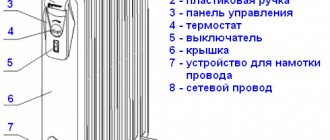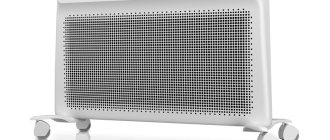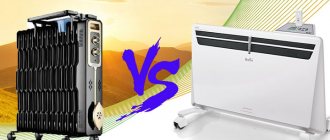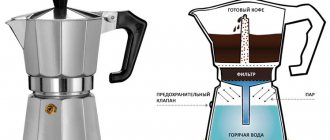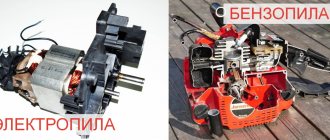You can heat the room in cold weather with any heater. However, the heating process will occur differently in each case. Therefore, many homeowners have to choose which heater is better, infrared or oil, and compare them with other types of convectors. It is possible to answer this question correctly only by studying the parameters, efficiency and other characteristics of each device.
Choosing which heater is better
Infrared
75%
Oil radiator
25%
Voted: 4
Operating principle of an infrared heater
The operating principle of infrared devices should be considered from the point of view of physical methods of transferring thermal energy in space. The main ones are:
- Convection. There is constant heat exchange in the air. Heated objects give off heat and heat the air, which, in turn, begins to rise upward. Heavier cold air currents take its place, and the whole process is repeated in the presence of a heat source.
- Radiant energy. All surfaces with a temperature above 60 degrees begin to intensely emit electromagnetic waves that have thermal energy. To obtain this effect, the waves must be in the range from 0.75 to 100 microns. This principle is used in the heating elements of IR heaters.
The heater itself is placed in a metal case coated with protective paint against corrosion. The internal part is filled with an aluminum reflector that acts as a heat emitter. It receives primary heat from heating elements.
The operating principle of an infrared heater is implemented in the following sequence:
- Current flows to the element and heats it.
- The element transfers its heat to the reflector - the heat-emitting plate.
- The heat reflected from the plate is emitted into space in the form of directed infrared rays.
- The rays hit surfaces within reach and heat them.
- Next, the principle of convection discussed above comes into play. Heat is transferred from surfaces and heats the surrounding air, providing uniform heating in a given area.
Infrared heater advantages and disadvantages
In the last decade, infrared heating systems have become increasingly used by our compatriots to heat their homes. The reason for this was the availability and fairly wide range of devices. Unlike oil radiators that heat the air, IR emitters heat objects in the room, which, in turn, release the accumulated heat to the air.
Infrared heater
To understand the question of which heater, oil radiator or infrared emitter should be chosen, it is necessary to consider all the advantages and disadvantages of these devices. In addition to accessibility, IR heating technology has many other advantages:
- Rapid heating of the room due to the large heat transfer area, which is the enclosing structures and interior items.
- Possibility of heating a certain area of the room located in the radiation zone.
- Silent operation, since the technology does not involve the presence of moving elements and mechanisms.
- Easy to install and operate.
- Small weight and dimensions.
- Economical.
- High efficiency (average 90%).
Infrared heaters are widely used for heating apartments, country houses, private and country houses, warehouses and industrial premises. There was also a “fly in the ointment”. Infrared heaters have one, but very important drawback - high cost.
Conclusion: IR heaters are very expensive, but durable, easy-to-use and economical electrical heating equipment used as the main or auxiliary heat source in residential, warehouse and industrial premises.
Comparison of an infrared heater with an oil heater
Everything can be learned by comparison, including choosing the most suitable heater. First of all, you need to compare their parameters, capabilities and functionality in relation to specific operating conditions.
What heats better is an oil radiator or an infrared one?
Heaters with coolant oil heat quite well, but at the very beginning after switching on they warm up very slowly. The heating process lasts approximately 30 minutes, and during this time the room will be either cold or cool. Many devices are equipped with fans that accelerate air movement, reducing heating time.
The length of infrared waves is identical to the sun's rays, so a person perceives heat in this way. The rays spread unhindered and are not afraid of wind or drafts. Effective heat exchange allows you to feel the warmth in the shortest possible time. It should be remembered that not the entire room is heated, but only those areas where the rays are directed.
The maximum room temperature is reached after operating the IR heater for several hours. After turning off the device, the surfaces still continue to give off heat, but not for long. In this case, oil radiators cool down much more slowly.
Which heater is more economical?
If you compare the efficiency of both devices and decide which is better, then, of course, IR devices win. Their electricity consumption is approximately 10-30% less than that of oil heaters with the same power. Similar savings can be achieved by reflective plates installed behind the heating elements.
However, the associated operating costs for oil radiators are significantly lower. They do not require spare parts, maintenance or expensive repairs. IR devices require periodic replacement of lamps or bulbs that have expired.
Therefore, each room should be carefully considered and assessed based on the feasibility of installing this particular device in it. Optimizing the use of heaters will go a long way toward balancing overhead costs.
Size comparison
Infrared and oil heaters have approximately the same dimensions. There are many different designs, models and options, one way or another related to the principles of operation of the devices. A lot depends on the power, which directly affects the dimensions of the device.
- Oil heaters are placed on the floor or wall. There are no ceiling models, since it is irrational to use such devices at the top. There will simply be nowhere for the warm air to rise.
- Infrared devices can be installed anywhere. Depending on the size and weight, they have legs, vertical stands, ceiling, wall and corner mounts.
What is the difference between an infrared heater and an oil heater?
Both infrared and oil heaters perform the same task in everyday life - they increase the temperature in the room and provide a comfortable microclimate. But the devices differ greatly in design and principle of operation.
The infrared radiator consists of several parts:
- housings;
- heating element;
- reflector;
- thermostat;
- control panels.
The principle of operation of the radiator looks like this - when turned on, the heating element of the device quickly heats up. After this, heat in the infrared spectrum begins to be transferred to surrounding objects. The IR device does not heat the air directly. Only the temperature of the surfaces located in the area of the radiator increases, and from them the heat transfers into space.
Infrared heaters do not dry out the air and are considered healthier
Attention! Infrared heaters are not only electric, but also gas and diesel. The first two varieties are used in everyday life, the latter is used in industrial facilities.
An oil heater is designed a little differently. It consists of the following elements:
- hollow body filled with oil;
- electric heating element;
- thermostat;
- sensors;
- device control panel.
When turned on, the radiator heating element first heats the oil poured inside the housing. Heat is gradually transferred to the metal walls of the device, and from them escapes into the surrounding space. As a result, the air temperature increases, although its humidity decreases significantly.
Oil radiators come in panel and sectional types, the latter have better heat transfer
Tips for choosing a heater for your home
In order to avoid unnecessary material waste when choosing an oil or infrared heater, you should adhere to certain rules. First of all, you need to consider the following factors:
- Place of installation of the device. It is recommended to determine in advance, since the type of heater and the efficiency of further heating directly depend on this. It should be taken into account that oil radiators are quite bulky, and falling is contraindicated for IR devices. In addition, they require certain installation methods. The most optimal models are wall-mounted. They cannot be touched by negligence, and they do not take up useful space in the room.
- Heater power for home. It is recommended to select this parameter according to a simple scheme: per 10 m2 of area, 1 kW of energy will be required for an oil radiator and 0.5 kW for an infrared device. Otherwise, the heater will not give the desired effect.
- Heater control. Mechanical and electronic systems are commonly used. The first option is cheaper, but it wears out quickly, has limited functionality, and has a high error in settings. Electronics, despite the high price, are much more efficient. Its precise operation makes using the heater more convenient and comfortable.
- Heating temperature. Oil-based appliances can become very hot during operation. Therefore, if you have small children, you should buy models where the surface of the radiator is protected by a frame that prevents direct contact with the hot surface. Among IR devices, there are micathermic devices that emit heat, but themselves remain cold.
Comparing technologies
The first thing that always worries the consumer is the cost of the device. For oil heaters-radiators and infrared heating devices, the prices are almost the same. However, for a little over three thousand domestic rubles you can purchase a fairly powerful and functional oil radiator, designed to heat a room with an area of 20 m2, or a carbon IR heater, with a radiator service life of about 2 years, minimal functionality, with a heating area of up to 12 m2.
Conclusion 1 : in the ratio of cost - functionality - efficiency, the oil heater won.
The second is electricity consumption. An oil radiator and an IR heater require different power to heat the same rooms. Based on this, infrared heating devices consume 30–50% less electricity than their oil-based competitors.
Conclusion 2 : IR heating devices win in terms of efficiency.
Third is operational safety. IR models can cause fire in objects located within 0.5 meters of the emitter. Carbon and halogen emitters will instantly fail if exposed to moisture. An oil cooler is safe. The surface temperature rarely exceeds 90°, so such a device is not capable of heating the surface of interior items before it ignites. In addition, such a device is not afraid of water and lack of air circulation: if it overheats, the security system will simply stop supplying power to the device.
Conclusion 3 : From a safety point of view, IR heaters are inferior to radiators
Fourth is the heating speed. An oil heater requires (on average) 30 minutes to reach full power. Infrared models begin immediately after switching on to heat objects and surfaces of enclosing structures.
Conclusion 4 : Infrared heating devices heat the room much faster.
So, according to the main criteria, parity is maintained between these devices. Both types of devices are suitable for creating and maintaining the desired temperature. That is why the decision of which heater to buy, a budget oil heater or an expensive infrared one, depends entirely on the characteristics of the room and the preferences of the buyer.
Heating a room faster with an infrared heater
Some tips for choosing a heater for your home
- Decide on the location of the device. The performance of the device and, to a large extent, the heating efficiency will depend on this. Oil models are bulky; IR heaters are drop resistant and require a specific installation method. Based on this, experts recommend paying attention to wall-mounted models.
- The efficiency of the device largely depends on its power. To correctly select an oil radiator, you need to focus on the following figures: 1 kW per 10 m2 of area. To calculate the required power of an infrared heater, use the following algorithm: 0.5 kW per 10 m2 of heated area.
- The device control system can be mechanical or electronic. Models with a mechanical system are much cheaper, but have a lot of disadvantages: rapid wear, limited functionality, high percentage of errors. Models with electronic control are expensive, but do not have these disadvantages and open up a lot of additional opportunities for the user.
- The surface of oil radiators can heat up to significant temperatures. If there are small children in the room, it is recommended to purchase models with a protected design, where the surface of the radiator is protected by a tubular frame that prevents contact with the device.
- When choosing an IR heater for a room with children, pay attention to micathermic models, the heating element of which emits thermal energy, but practically does not heat up.
Watch a video comparing heaters
Operation and care of heaters
Any device will last much longer if you follow simple rules during operation:
- You cannot place things to dry on a radiator that is on. This can only be done after first disconnecting the device.
- When the infrared heater is turned on, it should not be located near flammable objects. The distance from any objects should not be less than 50 cm.
- Avoid touching the electrical cord to the hot surface of the heater.
- Keep the device clean and regularly wipe away dust. In this case, the device must be turned off in advance and allowed to cool.
- Floor-standing models can only be used in a vertical position.
Operating principle of oil heater
The body of the oil heater consists of hermetically sealed metal sections coated with powder paint, which itself is very durable. It protects the heater body from possible mechanical damage. Mineral oil is poured inside the sections.
After turning on the heater, the heating element begins to gradually heat up, giving off thermal energy to the mineral oil with which the heater sections are filled. The oil heats the housing. It gives off heat to the air space of the room. Heated air rises upward according to the principle of convection, where it mixes with cold air. The air temperature is gradually increasing. The heating process is accelerated by fans that some manufacturers equip their heaters with.

